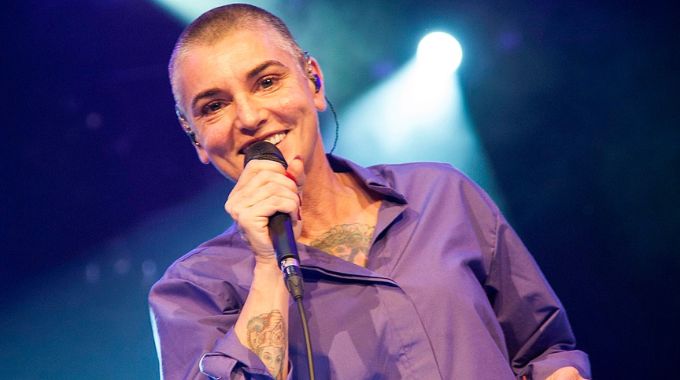
Sinéad O'Connor (1966 -2023) – Photo by Bryan Ledgard, CC BY 2.0, via Wikimedia Commons
CLN Editor Notes:
“Sinéad always spoke out against injustice. Sometimes she didn't say something perfectly. Sometimes her message wasn't always heard. But she never stopped trying. And I think that's really the key takeaway: is that she never, ever, ever stopped trying. And, it's not enough for us to now say that she was a brave warrior. We have to be brave warriors, and we have to have those conversations that she tried to spark from the very beginning of her career.” ~ Allyson McCabe, author of “Why Sinéad O'Connor Matters”
The passing of a public figure has never before moved me to tears, but I sobbed when I heard that Sinéad O'Connor had died at the age of 56. I didn't really know a whole lot about her other than her amazing voice, her mega-hit song, her shaved head, and her appearance on Saturday Night Live in which she tore up a photo of the pope. Still, I had this powerful feeling in my heart that an absolutely incredible human being had died and left a huge void. So, I decided to take a deep dive and find out as much as I could about her, some of which I share below.
In my research, I discovered that from the very beginning of Sinéad's career up until her final public appearance, this quote from Allyson McCabe was spot on: “Sinéad always spoke out against injustice.” When she was presented with the inaugural award for Classic Irish Album at the RTÉ Choice Music Awards in March of this year, Sinéad said: “I dedicate this to each and every member of Ireland's refugee community… You’re very welcome in Ireland. I love you very much and I wish you happiness.” Much of the world treats refugees as undesirable problems. Not Sinéad. She knows that they deserve love and happiness – just like every other person on the planet. See HERE.
And here's a great example from early in Sinéad's career in which she not only reveals a horrible injustice (the cause of the great famine in Ireland during the years 1845-1852), but she also offers a brilliant solution on how the Irish people can heal their collective trauma. (Note that the worst year of the period was 1847, known as “Black '47” – which Sinéad refers to in her absolutely brilliant song). Watch and appreciate this amazing woman:
As a result, some are now calling Sinéad a prophet – and I totally agree. Here's the best video on YouTube that I found about Sinéad's life and why she mattered: “A True Prophet”: Why Sinéad O’Connor Risked Her Career to Call Out Catholic Church. The above quote by Allyson McCabe is taken from this video, which is hosted by Amy Goodman of Democracy Now. Rather than tell you about it, I highly suggest that you watch for yourself.
This video, which includes an interview with Una Mullally, a columnist for the Irish Times in Dublin, is also outstanding: Why Sinéad O’Connor’s Legacy Is Deeper Than Her Music. Una said:
“I think Sinéad O'Connor goes beyond music. As you say, she's more of a cultural figure. She looms very large in the Irish psyche in terms of her activism, her politics, and her actions. And so, the loss is being felt really profoundly. It's almost as though it's a large political figure or even a spiritual figure who's been lost. So, there have been vigils and gatherings, and people are extraordinarily upset. I don't think I could really think of another person that this has happened within my lifetime.”
Sinéad's most famous act of revealing injustice was when she took a mind-blowingly bold stance against child abuse in the Catholic Church on live television. On October 3, 1992, without regard to the impact on her career, she sang a cappella the song “War” (a song by Bob Marley that emphasizes social justice, racial equality, and global peace) live on SNL before millions of TV viewers.
But Sinéad didn't sing “War” as it was written. Instead, she modified the song's lyrics to serve as a protest against the sexual abuse of children in the Catholic Church. She replaced mentions of “racism” with “child abuse” and “apartheid” with “in the Church. At the end of the song, Sinéad emphatically sang these lyrics that she added:
Children!
Children!
Fight!
We find it necessary.
We know we will win.
We have confidence in the victory of good over evil.
She then held up a photo of Pope John Paul II, tore it into pieces, and exclaimed: “Fight the real enemy!” (Watch HERE).
It took tremendous courage for Sinéad to do that. And she was widely ridiculed for it – by the press, celebs like Madonna and Joe Pesci, and of course, Catholic Church leaders – including Cardinal Bernard Law who was later exposed as being involved in the cover-up of sexual abuse within the Catholic Church in Boston (as depicted in the 2015 academy award winning film “Spotlight”). He resigned as Archbishop of Boston in 2002 due to the scandal.
Many members of the Catholic Church were outraged. In New York City, protesters transported a 30-ton steamroller to the Rockefeller Center and then proceeded to pulverize her cassette tapes.
Two weeks after her SNL performance, the audience attempted to boo Sinéad off the stage at a Bob Dylan tribute concert. But she stood tall amidst the loud booing for over 2 minutes before finally waving off the musicians, signaling that she no longer was going to sing the Bob Dylan song that she was scheduled to sing. Instead, she again sang the song “War” a cappella to drive home her message. Watch her incredible bravery HERE. Kris Kristofferson, who introduced and supported Sinéad at the concert with a hug and words of encouragement (“Don't let the bastards get you down”), gave one of the best tributes to her with the release of his song Sister Sinéad“, which appeared on his 2009 album titled “Closer to the Bone.” Be sure to check it out. Here's my favorite lyric:
It's askin' for trouble to stick out your neck
In terms of a target a big silhouette
But some candles flicker and some candles fade
And some burn as true as my sister Sinéad
History has proven that Sinéad's criticisms of the church were spot on. Just hours after her death was announced, an American group named Catholics for Choice called her a prophetic heroine “unafraid to demand justice for victims of clerical sexual abuse, challenge patriarchy, and speak truth to power — even when her voice was a lonely one and it cost her dearly to do so.”
Be sure to read this outstanding article about, among other things, how Sinéad's traumatic real-life experiences led to her courageous stance on the SNL stage and throughout her entire life: “Sinead O’Connor Condemned Church Abuse Early. America Didn’t Listen.”
Do yourself a favor and WATCH THIS absolutely wonderful 2-minute video that was posted in 2017, in which another famous Irish singer, Imelda May, describes the first time she met Sinéad and what an incredibly kind and sensitive soul Sinéad was. Imelda also noted that it was Sinéad's idea for the two of them to sing a duet together, of which Imelda fondly recalled: “I think that's probably one of the most heartfelt songs I've ever performed with somebody, for sure. The two of us, it's just magic for me.” So now, you really must watch THIS fabulous duet that Imelda spoke about, titled “Every Night About This Time.”
THIS LIVE PERFORMANCE wonderfully captures the beauty and purity of Sinead's voice as she sings a capella an incredibly beautiful song that she wrote titled “In This Heart” (which was featured on the hit series “Peaky Blinders” – see HERE). Also, be sure to listen to Sinéad's most recently published recording HERE. After hearing Sinéad sing this hauntingly beautiful, 90-second theme song for Outlander titled “The Skye Boat Song,” a friend of mine observed: “She conveys so much emotion in her voice. Whatever the message, it's always more than words if she sings it!”
To get a feeling for just how beloved Sinéad is in her home country, watch this 2-minute video titled “She was fierce in the best sort of way: Dubliners turn out to pay tribute to Sinéad O'Connor“. My favorite quote from the video (in addition to the one in the video's title) is: “I don't think I've ever cried so much for a stranger, but I think she held bits of generations of this nation in her heart. She was saying things before we could say them.”
Finally, watch THIS touching video clip from Sinéad's funeral in the Irish town of Bray where thousands of adoring fans flocked to pay their respects. Several residents who had the good fortune to meet her are interviewed.
Thank you, Sinéad, for being a shining beacon of transformation and a heartfelt inspiration to all of us. May your music eternally resonate, uplifting us to stand up and voice our truths against injustice, and celebrate our true selves. This music video, in which you remind us to love ourselves, depicts how I will remember you – a radiant light, overflowing with love, joy, and wisdom:
RIP beautiful soul. I am really glad that you are reunited with your beloved son.
Sinéad O’Connor: A Troubled Soul With Immense Talent and Unbowed Spirit
Written by: Adam Behr, Newcastle University
Few artists have straddled the boundaries between acclaim, controversy and public affection as effectively as Sinéad O’Connor who died yesterday at the age of 56.
Her status as a household name belied a comparatively brief commercial peak in the early 1990s, thanks to her mesmerizing interpretation of Prince’s Nothing Compares 2 U. But she was never in any danger of being relegated to being a one-hit-wonder.
O’Connor’s life and career were characterized by irregularity and a sense of being at odds with her surroundings. Her childhood was fraught. After her parents separated when she was young, O’Connor lived mostly with her mother, who she claimed was abusive, and involved her in shoplifting and fraudulent charity collecting.
Truancy and crime led to a spell in the Catholic church-run Grianán Training Centre, a harsh rehabilitation centre associated with the infamous Magdalene Laundries. Although traumatic, the center provided her with an entry into music when a teacher asked her to sing at a wedding, which led to encounters with musicians who encouraged her to write lyrics and pursue the guitar.
Adversity infused her music with a punk spirit, an oppositional attitude that was writ large throughout the rest of her career. By the time her mother died in a car crash when O’Connor was 18 years old, the singer was well on her way. She had dropped out of school and formed a band called Ton Ton Macoute – with typically spiky attitude – a name derived from a mythical Haitian bogeyman, and also the dictator Papa Doc Duvalier’s feared secret police.
A distinctive template as a singer-songwriter
Having captured the attention of former U2 label boss Fachtna O'Ceallaigh, and collaborated with The Edge on a song for the film Captive, her solo career began in grand style with The Lion and the Cobra in 1987. A gold record in the UK, US, Canada and the Netherlands – featuring the Top 40 single Mandinka – it marked out her image and distinctive voice, clear and pure, but never demure.
Her trademark cropped hair and forthright bearing set her apart from prevailing female singer-songwriters. Shunning both overtly sexualized imagery and quirky hippie-chick vibes, O’Connor’s aesthetic was blunt and raw, although the clarity of her voice gave it commercial traction.
This reached a pinnacle on her next album, 1990’s I Do Not Want What I Haven’t Got – a multi-platinum worldwide number one that featured her best-known recording, Nothing Compares 2 U which she made completely her own. Propelled by a stark video in unflinching close-up, tears running down her face, it made her an international star. But O’Connor’s predilection for musical exploration, political confrontation and emotional honesty meant that her mainstream career quickly self-combusted.
Despite the success of her early recordings, she took a counter-intuitive turn on her next album, 1992’s Am I Not Your Girl?, which featured lush versions of jazz standards. While her voice was more than up to the task of interpreting the classics she had grown up with, the departure from her previous work saw a critical and commercial step down from the trailblazing success of her previous album. More significantly, she used her promotional activity in America to showcase her status as a protest singer rather than a pop star.
Given the centrality of her personal, and musical, voice to her career, it’s perhaps apt that two of her most notable live performances are both a cappella and confrontational. An appearance on TV show Saturday Night Live in October 1992 saw her drop the planned performances of standards from the album and replace them with a version of Bob Marley’s War. She wanted to re-tool it as a protest against child abuse in the Catholic church, and the cover-up that followed. The change of song was agreed by the show’s producers.
What they hadn’t planned on was for O’Connor to tear up a picture of the Pope at the denouement of the performance. The subsequent furor was swift and intense. O’Connor was vilified in the press, and the NBC network received over 4,000 complaints. Two weeks later, at a star-studded tribute to Bob Dylan, she was booed by the crowd and stopped the band to shout another rendition of War before leaving the stage in tears, comforted by Kris Kristofferson.
Watch Sinéad's compassionate response when asked: “How were you treated when you said ‘Fight the real enemy' and you ripped up the picture of the pope? How were you treated after?”:
Unbowed and iconic
Even if her career never quite acquired equilibrium, O’Connor the artist remained unbowed and exploratory. Taking lessons in Italian bel canto singing, her subsequent seven albums tacked across genres – reggae, hip-hop, rock, soul, and folk – placing her voice at the centre of original material and distinctive interpretations of an eclectic range of artists from Curtis Mayfield to Kurt Cobain.
Her later releases were stronger on critical acclaim than commercial clout, and her well-publicized mental health difficulties led to hiatuses in her music. Ever the controversialist, she continued to weigh in on points of principle, such as her critique of Miley Cyrus over the sexualized video for Wrecking Ball, and the subsequent public spat.
Despite these gaps, and the personal tragedies like her son’s suicide in 2022, O’Connor’s fierce adherence to her principles of self-expression saw her win considerable public affection. She was, of course, vindicated over her accusations of abuse in the Catholic church. But her uneven approach to public life – announcements of retirement followed by retractions, a spell as a “priest” followed by her conversion to Islam (she went by the name Shuhada’ Sadaqat from 2019) – did little to dim her appeal in the long term.
Ultimately despite her difficulties, or even because of them, she exemplified what it was to be an icon. Her visual distinctiveness, determination and refusal to meet the mainstream halfway mean that her instantly recognisable voice cut through the shifts and uncertainty of her personal life and public debate. In the end, nothing quite compares to her.![]()
Adam Behr, Senior Lecturer in Popular and Contemporary Music, Newcastle University
This article is republished from The Conversation under a Creative Commons license. Read the original article.

















She certainly was a courageous woman.